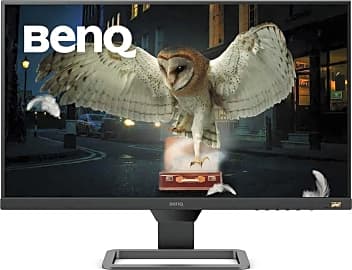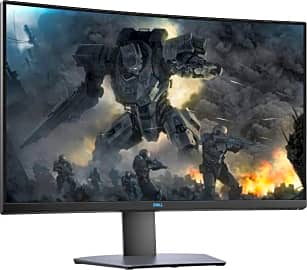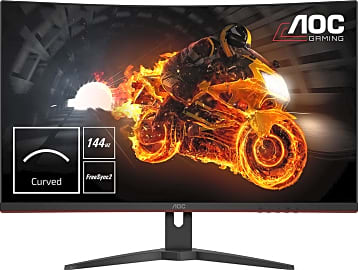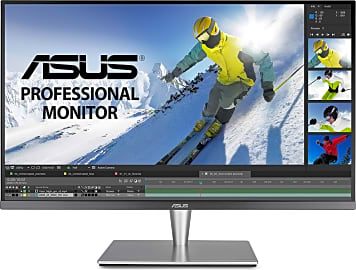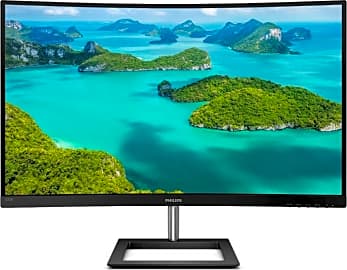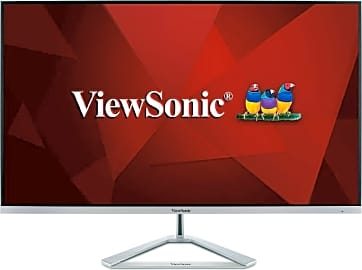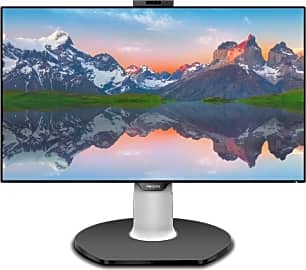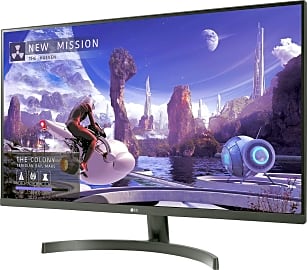The 10 Best 32 Inch Monitors

This wiki has been updated 26 times since it was first published in November of 2018. As computers increase in power and graphics become ever-more-detailed and lifelike, many consumers are upgrading to extra-large, 32-inch monitors. Offering more real estate and higher resolutions on average than their more diminutive counterparts, these modern displays will help any system look its best. Here you'll find the finest options for professionals, gamers, and casual users alike. When users buy our independently chosen editorial picks, we may earn commissions to help fund the Wiki.
Editor's Notes
July 12, 2020:
Even though the cutting edge of display technology has been just a bit stagnant over the past few months in the consumer scene, it's still no surprise that some of the most reliable and best-looking aspects have been combined into highly refined packages. The BenQ EW3280U, for example, is the latest in a long line of monitors both respected and loved by gamers and professionals alike. The same can be said for the Dell S3220, which takes over for Dell's highly lauded Alienware line this year and is an impressive piece of equipment overall. The latest 32-inch Dell Ultrasharp, on the other hand, isn't brand new this year, but still looks subjectively better than much of the competition according to demanding users.
From a manufacturer known for their extremely accurate color reproduction, the Asus PA32UC should satisfy all but the most picky audiovisual professionals, and the same company offers a couple super-high-end options, one of which can be found in our Special Honors section. The Philips Brilliance 329P9H is another highly accurate option, and while it does cost less than the Asus, it's not quite as consistent and still is pretty expensive.
You certainly don't have to spend an arm and a leg, though, to get something worthwhile. Of particular note is the AOC CQ32G1, which this article and editor's note were written on. There's really nothing bad to say about this monitor, especially at its relatively low price point. Similarly, the Philips 325E1C, ViewSonic VX3276, and especially the LG QN600 are surprisingly good choices considering their cost, although you'll want to make sure that each has the refresh rate and ergonomic adjustments you need, as they each sacrifice something that more expensive models will usually have.
It's also worth nothing that if you're looking for something variable refresh rate support and you have an Nvidia graphics card, a significant portion of AMDFreeSync-enabled displays are now compatible with G-Sync as well, although you'll have to use the GPU's DisplayPort to take advantage of this. That said, depending on which FreeSync monitor you choose, you'll want to make sure you research other users' experience with its G-Sync compatibility beforehand, just be sure, as they don't all behave the exact same way. You'll also want to update your drivers to give G-Sync the best possible chance of working correctly.
November 12, 2018:
The 32-inch class is at the very top end of the comfortable size range for most consumers. In fact, mathematically speaking, a 32-inch, 1440p monitor, sitting desk-distance from your face, is just about the ideal resolution and distance for maximum visual benefit (but, of course, everybody's eyes are different). LG, Dell, and HP all make displays that simply look better than most others, sometimes in an intangible way. Gamers, take note of your GPU family and the variable refresh tech available; in keeping with long-standing tradition, AMD video cards as well as AMD Freesync are both considerably less expensive than the opposition. On the other hand, ViewSonic is a long-time favorite among budget-oriented users of all types.
Special Honors
ASUS ProArt Display PA32UCG As one of the first displays in this size to offer 4K at 120 hertz, and one of the only of any size with a true 10-bit panel, this is definitely a technological marvel, although it will cost you quite the pretty penny. If you can afford it, though, it's a great choice for high-end gaming, photo and video editing, and any other task you can imagine. asus.com
Apple ProDisplay XDR If you're okay with making a huge investment, this iconic Retina display is worth a look - but only if you plan on connecting it to an Apple computer. It offers a peak brightness of 1,600 nits, a superwide viewing angle, and pixels packed so tightly together that you'll be hard-pressed to make a single one of them out. apple.com
Eizo ColorEdge CG319X Photo and video professionals will appreciate the high-tech and high-accuracy capabilities of this powerful model, which very much upholds its manufacturer's stellar reputation. The average user won't need all of its bells and whistles, but it's hard to overlook its superior panel and HDR processing technology. eizo.com
Through Thick And Thin
Throughout the 1990s, researchers labored over the exact designs that would not only increase visual fidelity, but also remain easy to produce.
For as bulky and inefficient as its design was, the cathode-ray tube display was able to dominate nearly a century of television and two decades of PC displays. In some ways, it was simpler than modern display panels; the cathode produced a beam of excited electrons when powered, and that beam was focused and deflected by various coils en route to the fluorescent screen, where simple physics translated the electrons into visible light.
Laptops were the first computers to largely do away with CRT technology; early notebooks came in black and white as well as color configurations and the display was a costly part of the portable computing experience. Throughout the 1990s, researchers labored over the exact designs that would not only increase visual fidelity, but also remain easy to produce. By 2007, thanks to the R&D departments at massive companies like Hitachi and Samsung, flat-panel LCDs surpassed CRTs in performance and started to become mainstream around the world.
What's In A Monitor
The two most basic specifications of computer displays are the resolution and refresh rate. The resolution refers to exactly how many pixels the screen has and the refresh rate is the number of times per second that those pixels are updated. Most displays use a 16:9 aspect ratio, and resolutions range all the way from 1280 x 720 resolutions all the way to 4K and in a few cases, even higher. Sixty hertz is the most common refresh rate.
Resolution is a different story. As screen size increases, given the same resolution, an image will look less and less sharp. Plus, when it comes to actual desktop space, more pixels means more screen real estate; If the display isn't big enough, though, words on a 4K screen might just be too small to read. But if you're talking about a 32-inch monitor, a Quad HD or 4K model might be the perfect size and sharpness.
A low response time reduces motion blur, which makes fast-paced scenes appear more smooth.
But while important, there's more to pay attention to than resolution and refresh rate. Advanced LED technology has allowed recent computer displays to make huge strides in terms of contrast ratios, black levels, and brightness. Some high-end manufacturers have adopted quantum dot filtration, which streamlines the coloring process and allows for more accurate colors, wider gamuts, and considerably less light bleed and inconsistency. Then there's HDR, a dynamic lighting protocol that transmits localized brightness and contrast metadata. This ever-advancing technology can bring an even bolder and more lifelike appearance to images, especially real-world pictures and videos.
There are additional aspects that are mostly worthwhile to gamers. Powerful gaming machines can often exceed 60 FPS at high resolutions, so gamers tend toward high refresh rates when looking for a high-performance monitor. But, there's more. When a graphics card sends a video signal at 60 hertz, each frame is displayed once per refresh, but if that frame rate changes (which it's very likely to do), the monitor may end up drawing two frames at once, or not replacing a current frame on time, which leads to screen tearing or a minor shake called judder. The solution to this is called variable refresh rate, which lets the monitor synchronize with the frame rate it's being fed, eliminating distracting tearing and artifacts. There is an open standard for VVR, but major GPU producers like AMD and Nvidia also have specialized protocols for it that work especially well with their branded cards.
Then, there's pixel response time. Not to be confused with input lag, which is the time it takes for a command from the mouse or keyboard to activate on screen, response measures the time it takes for each pixel to go from white to gray and back again. A low response time reduces motion blur, which makes fast-paced scenes appear more smooth. It can also prevent ghosting, a phenomenon where images that have already left the screen are visible for just enough milliseconds to be noticed.
What Are Your Options?
With a 32-inch monitor at 4K resolution, you can sit about two feet away with 20/20 vision and you won't be able to make out any individual pixels. In fact, with a screen so large, 1080p is likely to be unsatisfying, which is why the majority of options at this size are offered with at least 2560 by 1440 panels, a resolution also known as Quad HD.
With a 32-inch monitor at 4K resolution, you can sit about two feet away with 20/20 vision and you won't be able to make out any individual pixels.
While most 32-inch monitors are traditional flat 16:9 rectangles, you'll run into some that are curved, and some that are in a 21:9 aspect ratio. Once again, gamers take note, as a curved display can make games that much more immersive, as can an ultrawide display, although some titles take a little extra tweaking to actually display in 21:9.
If 32 inches isn't big enough, your next-best option might be to consider an actual television. Most are limited to 60 hertz, so if you want to take advantage of frame rates above that, you may be out of luck. Until HDMI 2.1 becomes the industry standard, PC graphics cards are unable to output anything above 4K at 60 hertz, because there simply isn't enough bandwidth to transmit all the signal. For the forseeable future, though, it may be hard to maintain a frame rate over 60 in Ultra HD in most games, anyhow. If you do go this route, make sure to choose a TV that has a relatively low input lag, especially if you're gaming, as heavily lagging mouse and keyboard inputs can be particularly infuriating.
All in all, there are more high-quality displays on the market than ever before, and the selection won't be shrinking anytime soon. It's surprisingly easy to find an option in your price range; although you might have to make a couple sacrifices as far as the newest technologies go, even budget-oriented companies are now making highly reliable displays with great pictures. And if you are a performance enthusiast, you will of course want to make certain you're using the latest and most powerful hardware to get the most out of your new monitor.


